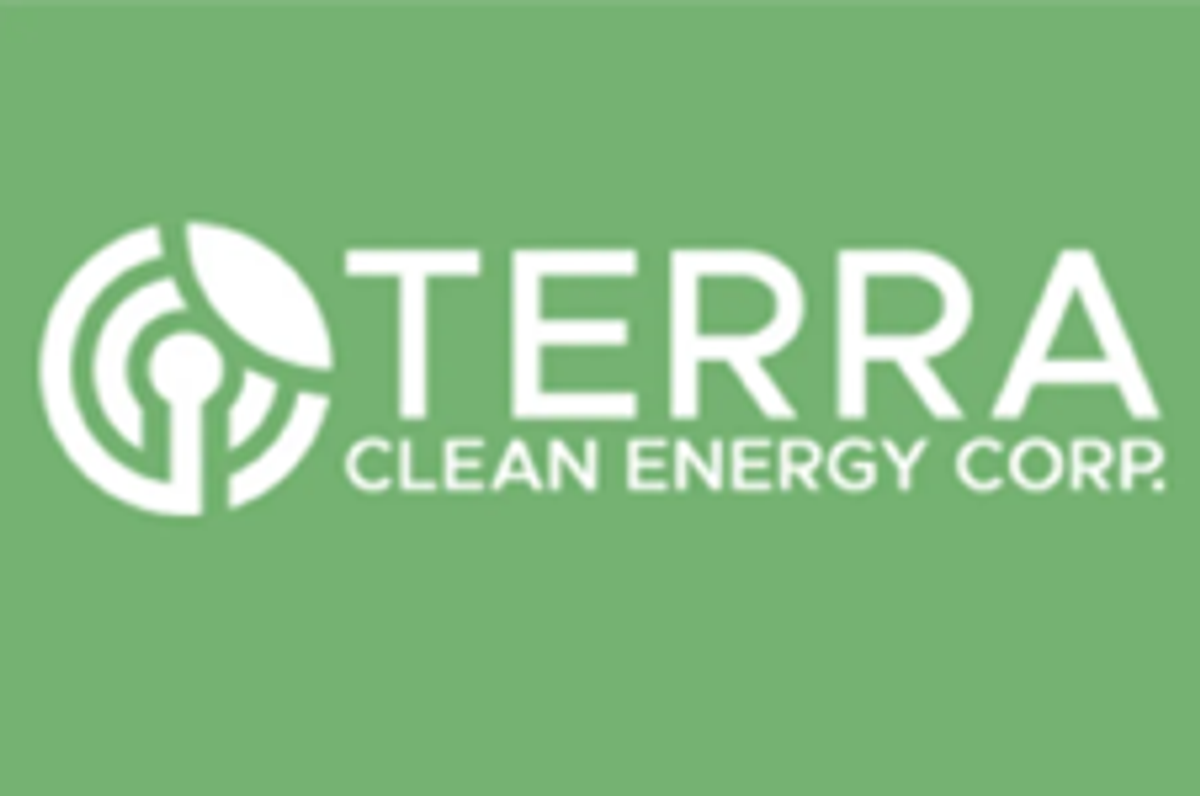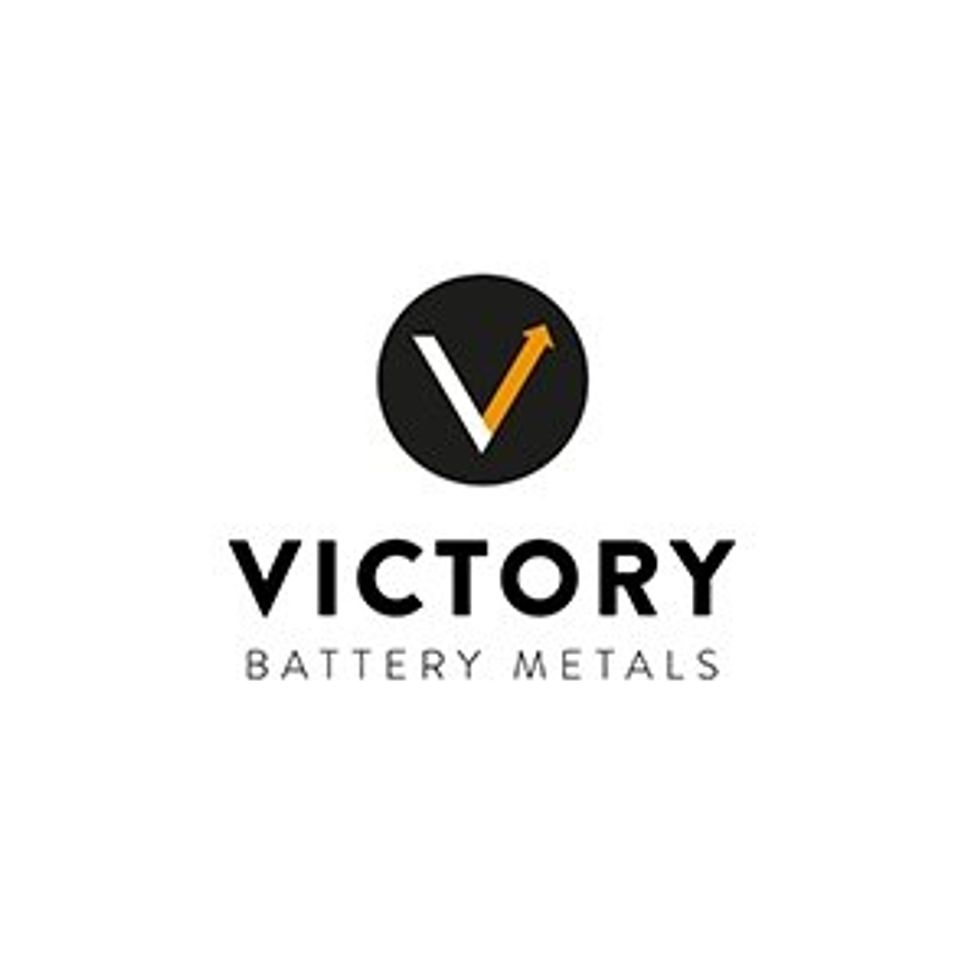
August 30, 2024
Victory Battery Metals Corp. (CSE:VR)(FWB:VR6)(OTC PINK:VRCFF) ("Victory" or the "Company") announced that it has closed its previously announced acquisition of the Yellow Chief Uranium Inc. properties located in Utah and Saskatchewan. The Company issued 8,000,000 common shares at a deemed price of $0.05 in accordance with the terms of the June 26, 2024 Option Agreement.
The common shares are subject to a four-month and one-day hold period.
The Company advised that when originally signed, the agreement was an arms length transaction, but the Yellow Chief. CEO subsequently became the CEO of the Company. If the transaction were to be classifed as a related party transaction, the Company would note that as such participation was less than 25% of the market capitalization of the Company at the time, the Company would rely on the exemptions from the valuation and minority shareholder approval requirements of MI 61-101 contained in sections 5.5(a) and 5.7(a) of MI 61-101 in respect of such insider participation.
About Victory Battery Metals
Victory is a publicly traded diversified investment corporation with mineral interests in North America. The Company's head office is located at 1780-355 Burrard Street, Vancouver, BC, V6C 2C8, and its Common Shares are currently listed on the CSE.
Contact Information
For further information, please contact:
David Stadnyk, President
Phone: +1 (236) 317-2822 or toll-free +1 (855) 665-GOLD (4653)
E-mail: info@victorybatterymetals.com
www.victorybatterymetals.com
Cautionary Statement Regarding Forward-Looking Information
Statements in this press release regarding the Company which are not historical facts are "forward-looking statements" that involve risks and uncertainties. Such forward-looking information can be generally identified by terms such as "may", "expect", "estimate", "anticipate", "intend", "believe", and "continue" or the negative thereof or similar variations. Since forward-looking statements address future events and conditions, by their very nature, they involve inherent risks and uncertainties. The Company provides forward-looking statements for the purpose of conveying information about current expectations and plans relating to the future, and readers are cautioned that such forward-looking statements may not be appropriate for other purposes. By its nature, this forward-looking information is subject to inherent risks and uncertainties that may be general or specific and which give rise to the possibility that expectations, forecasts, predictions, projections or conclusions may not prove to be accurate, that assumptions may not be correct, and that objectives, strategic goals and priorities may not be achieved. These risks and uncertainties include but are not limited to those identified and reported under the Company's disclosure documents available on its SEDAR+ profile at www.sedarplus.com.
Neither the CSE nor its Regulation Services Provider (as that term is defined in the policies of the CSE) accepts responsibility for the adequacy or accuracy of this press release.
VR:CA
The Conversation (0)
30 June
John Ciampaglia: Uranium Turnaround? Spot Price Pop, Stocks and SPUT Raise
John Ciampaglia, CEO of Sprott Asset Management, discusses uranium supply, demand and pricing, also sharing details on the Sprott Physical Uranium Trust's (TSX:U.U,OTCQX:SRUUF) recently closed US$200 million bought-deal financing.
"It's clearly acted as a very positive catalyst — the spot price has popped, a lot of the equities have popped on this," he said about the agreement.
Don't forget to follow us @INN_Resource for real-time updates!
Securities Disclosure: I, Charlotte McLeod, hold no direct investment interest in any company mentioned in this article.
Keep reading...Show less
30 June
13 Uranium Companies Exploring Canada's Athabasca Basin
Uranium market watchers know that Canada’s Athabasca Basin is among the world’s richest uranium jurisdictions and hosts several of the highest-grade uranium deposits on the planet.
Spanning close to 100,000 square kilometers of the Canadian Shield of Northern Saskatchewan and Alberta, the Athabasca Basin is a major contributor to Canada’s status as the second largest uranium producer and the third largest country by uranium reserves.
Unsurprisingly, the region is home to the world’s largest uranium mine, Cigar Lake. The mine reports average grades of 14.69 percent U3O8 and accounts for 14 percent of global uranium production.
First commissioned in 2014, Cigar Lake is operated by uranium major Cameco (TSX:CCO,NYSE:CCJ), which holds a 54.547 percent stake in the mine, as part of a joint venture with Orano Canada at 40.453 percent and TEPCO Resources at 5 percent. Ore from the underground mine property is processed at Orano’s McClean Lake mill, located 70 kilometers from the mine.
Uranium was first discovered in the Athabasca Basin in 1934, and today the region remains a major hot spot for uranium exploration. In recent years, a number of Athabasca Basin uranium companies have made exciting new discoveries, sparking a staking rush by others looking to get in on the action.
Athabasca Basin uranium exploration companies
With that in mind, the Investing News Network has put together this list of uranium companies with exploration and development stage projects in the Athabasca Basin. The companies are listed below in alphabetical order. The information about their projects and assets was current as of June 9, 2025.
1. ATHA Energy (TSXV:SASK,OTCQB:SASKF)
ATHA Energy has an extensive uranium exploration pipeline across Canada, including in Saskatchewan’s Athabasca Basin. At 3.8 million acres, ATHA’s land package in the Athabasca Basin includes the Gemini project, a basement-hosted near-surface uranium deposit with uranium intercepts of between 6,190 and 96,600 parts per million.
The company also holds a 10 percent carried interest in exploration projects operated by NexGen Energy (TSX:NXE,NYSE:NXE) and IsoEnergy (TSX:ISO).
2. Azincourt Energy (TSXV:AAZ,OTCQB:AZURF)
Azincourt Energy has two uranium projects in Canada, one of which is its East Preston joint venture project near the southern edge of the Western Athabasca Basin. Azincourt has an 86.5 percent interest, with the remainder held by Skyharbour Resources. The 20,647 hectare property is adjacent to Skyharbour's minority-owned Preston project.
Azincourt says it is targeting basement-hosted unconformity-related uranium deposits in two prospective conductive, low-magnetic-signature corridors. The company is planning for a fall 2025 geophysics exploration program at East Preston in preparation for a potential winter 2026 diamond drill program.
3. Baselode Energy (TSXV:FIND)
Baselode Energy's strategy is developing assets near the Athabasca Basin with similar geology. Its ACKIO near-surface uranium discovery at its Hook project is located directly adjacent to the Athabascan Basin. First discovered by the company in September 2021, the ACKIO near-surface uranium prospect is more than 375 meters along strike, and more than 150 meters wide.
Baselode has identified at least nine separate uranium pods, or small bodies of mineralization, on the project. Drill results from its summer 2024 exploration program were released in May 2025, demonstrating the potential for further expansion of the known uranium mineralization at ACKIO.
4. CanAlaska Uranium (TSXV:CVV)
CanAlaska Uranium is a project generator with interests in a portfolio of assets in the Athabasca Basin covering 1.24 million acres. The company is advancing its West McArthur joint venture with Cameco, which is situated near the McArthur River mine in the Eastern Athabasca Basin. CanAlaska owns 85 percent of the project.
CanAlaska’s 2025 C$12.5 million drill program at West McArthur is aimed at expanding and delineating the high-grade Pike Zone uranium discovery.
Earlier this year, the company completed the first drilling in over 10 years at its wholly owned Cree East deposit in the south-eastern portion of the Basin. The drill program was fully funded by Nexus Uranium (CSE:NEXU,OTCQB:GIDMF) as part of an option earn-in agreement to earn up to 75 percent interest in the project.
5. Denison Mines (TSX:DML)
Uranium miner Denison Mines’ direct ownership interests in the Athabasca Basin region covers approximately 384,000 hectares. The company has a 22.25 percent stake in the McClean Lake mine and mill joint venture project operated by Orano Canada.
Denison’s flagship project in the region is Wheeler River, considered the largest undeveloped uranium project in the eastern region of the Athabasca Basin. Wheeler River hosts the high-grade Phoenix and Gryphon deposits.
According to a 2023 feasibility study, Phoenix hosts a proven and probable resource of 219,000 metric tons at an average grade of 11.7 percent uranium for 53.3 million pounds. The company plans to develop the deposit as an in-situ recovery operation.
The Canadian Nuclear Safety Commission is slated to conduct hearings for the project’s environmental assessment and license on October 8 and December 8 to 12, 2025. If approval is granted, the company is looking to break ground in early 2026 and commence production by the first half of 2028.
As for the Gryphon deposit, Denison has evaluated it as a conventional mine in a pre-feasibility study. The company conducted a field program in the first quarter 2025 that may be used for a future feasibility study.
6. F3 Uranium (TSXV:FUU,OTCQB:FUUFF)
F3 Uranium has three exploration properties in the western region of the Athabasca Basin: the advanced-stage Patterson Lake North project, which hosts the JR discovery, as well as the early-stage Minto and Broach projects.
In February 2025, the company launched a drill campaign at its Patterson Lake North project followed by ground geophysical exploration programs at its Broach and Minto projects. F3 Uranium raised C$7 million in flow-through shares in May 2025, which will go towards further exploration of its uranium projects.
7. Forum Energy Metals (TSXV:FMC,OTCQB:FDCFF)
Forum Energy Metals has numerous wholly owned and joint venture projects hosting new discoveries of high-grade unconformity-related uranium deposits in the Athabasca Basin. So far in 2025, the company’s focus has been on the Northwest Athabasca (NWA) project, a joint venture between Forum at 45.4 percent, NexGen Energy at 25.3 percent, Cameco at 18 percent and Orano Canada at 11.3 percent.
Early in the year, Forum announced an option agreement allowing Global Uranium (CSE:GURN,OTCQB:GURFF) to earn up to 75 percent of Forum’s stake in the property by spending C$20 million in exploration expenditures at NWA.
In April, Global Uranium completed a diamond drilling program and ground geophysical surveys on the project, which intersected elevated radioactivity and alteration systems distinct to unconformity-type uranium mineralization.
8. IsoEnergy (TSX:ISO)
IsoEnergy has a portfolio of projects and joint ventures in the Eastern Athabasca Basin, and its main focus is the Hurricane deposit at its wholly owned Larocque East uranium property.
The company discovered Hurricane in 2018 and it now stands as the world's highest-grade indicated resource of uranium. A 2022 resource estimate reported an indicated high-grade resource of 63,800 metric tons grading 34.5 percent uranium for 48.61 million pounds of contained uranium.
IsoEnergy's summer exploration program will include drilling to test potential resource expansion at Larocque East as well as exploration at its other Athabasca Basin projects.
9. NexGen Energy (TSX:NXE,NYSE:NXE)
NexGen is another uranium mining company with a large land package in the basin, including its development-stage Rook I project.
Rook I has a measured and indicated resource estimate of 256.7 million pounds contained uranium from ore grading an average of 3.1 percent U3O8. The 2021 feasibility study outlines an 11.5 year initial mine life with up to 29.2 million pounds of U3O8 production per year for the first five years.
The Federal Environmental Impact Statement for Rook I was accepted in January 2025, and the Canadian Nuclear Safety Commission has proposed hearing dates for the project on November 19, 2025, and February 9 to 13, 2026. NexGen plans to immediately begin construction activities following final federal approval.
10. Paladin Energy (TSX:PDN)
Paladin Energy's Patterson Lake South (PLS) project hosts the large, high-grade and near-surface Triple R deposit, which has the potential to produce both uranium and gold. The company acquired it as part of its acquisition of Fission Uranium in 2024. Paladin also holds six early-stage uranium projects in the basin.
PLS's mineral reserve estimate includes probable reserves of 93.7 million pounds from 3 million metric tons of ore at an average grade of 1.41 percent U3O8. The 2023 feasibility study demonstrates life of mine production of approximately 9 million pounds U3O8 per year over a 10 year mine life.
The company released positive drill results from its winter drill program on the Saloon East zone in June 2025 showing the potential to further grow the resource base of the property outside of the Triple R deposit. The project is advancing through the environmental permitting process.
11. Purepoint Uranium (TSXV:PTU)
Purepoint Uranium has an extensive uranium portfolio, including six joint ventures and five wholly owned projects all located in the Athabasca Basin.
Purepoint has a significant joint venture relationship with IsoEnergy (TSX:ISO) that includes a 50/50 joint venture agreement to explore 10 uranium projects across 98,000 hectares in the eastern portion of the Athabasca Basin. The partners launched a 2025 drill campaign in May at the Dorado project, which will include approximately 5,400 meters across 18 holes, targeting high-priority electromagnetic conductors for uranium mineralization.
Its joint ventures also include the Hook Lake uranium project in the Patterson region, in which it owns a 21 percent interest alongside Cameco and Orano Canada, which both hold 39.5 percent.
12. Skyharbour Resources (TSXV:SYH,OTCQX:SYHBF)
Skyharbour Resources is another junior mining company with an extensive portfolio of uranium exploration projects in the Athabasca Basin, comprising 36 uranium projects over 614,000 hectares. The company's core projects include its 57.7 percent owned Russell Lake project — a joint venture with Rio Tinto (ASX:RIO,NYSE:RIO,LSE:RIO) — and its wholly owned Moore project.
Skyharbour’s 49,635 hectare Preston uranium project in the western portion of the Athabasca Basin is the subject of a 7,000 meter 2025 summer drill campaign being conducted by its joint venture partner, Orano Canada. Orano is the majority owner and operator at the project at 53.4 percent, while Skyharbour owns a minority interest of approximately 25.6 percent. The remainder is held by Dixie Gold.
13. Standard Uranium (TSXV:STND,OTCQB:STTDF)
Standard Uranium is an emerging project generator that holds interest in over 94,476 hectares in the Athabasca Basin, including its flagship Davidson River project in the southwest region of the basin.
In spring 2025, Standard Uranium partnered with Fleet Space Technologies Canada on three ExoSphere Multiphysics survey grids across the Warrior, Bronco and Thunderbird conductors at Davidson River. The surveys will provide important data for upgrading drill targets across the property through imaging of density anomalies in the basement rock.
This is an updated version of an article first published by the Investing News Network in 2015.
Don’t forget to follow us @INN_Resource for real-time updates!
Securities Disclosure: I, Melissa Pistilli, hold no direct investment interest in any company mentioned in this article.
Editorial Disclosure: Baselode Energy, PurePoint Uranium and SkyHarbour Resources are clients of the Investing News Network. This article is not paid-for content.
Keep reading...Show less
30 June
Terra Clean Energy: Advancing an Expansive Uranium Landholding in the Prolific Athabasca Basin
Terra Clean Energy (CSE:TCEC,OTCQB:TCEFF,FSE:C9O0) is advancing its 100 percent-owned South Falcon East Project, strategically located in the southeastern Athabasca Basin, Saskatchewan — one of the world’s premier uranium districts. The project stands out among uranium juniors for its shallow mineralization, strong discovery potential, and proximity to established infrastructure.
Anchored by a historical resource of nearly 7 million pounds (Mlbs) U₃O₈ at the Fraser Lakes Zone B, the project also hosts multiple zones of confirmed mineralization and structural alteration. Terra is advancing toward a NI 43-101-compliant resource update in 2025, with the goal of materially expanding its resource base. Situated along the highly prospective Way Lake Conductor — a folded, uranium-enriched corridor — the project offers significant upside for new discoveries beyond the existing resource.
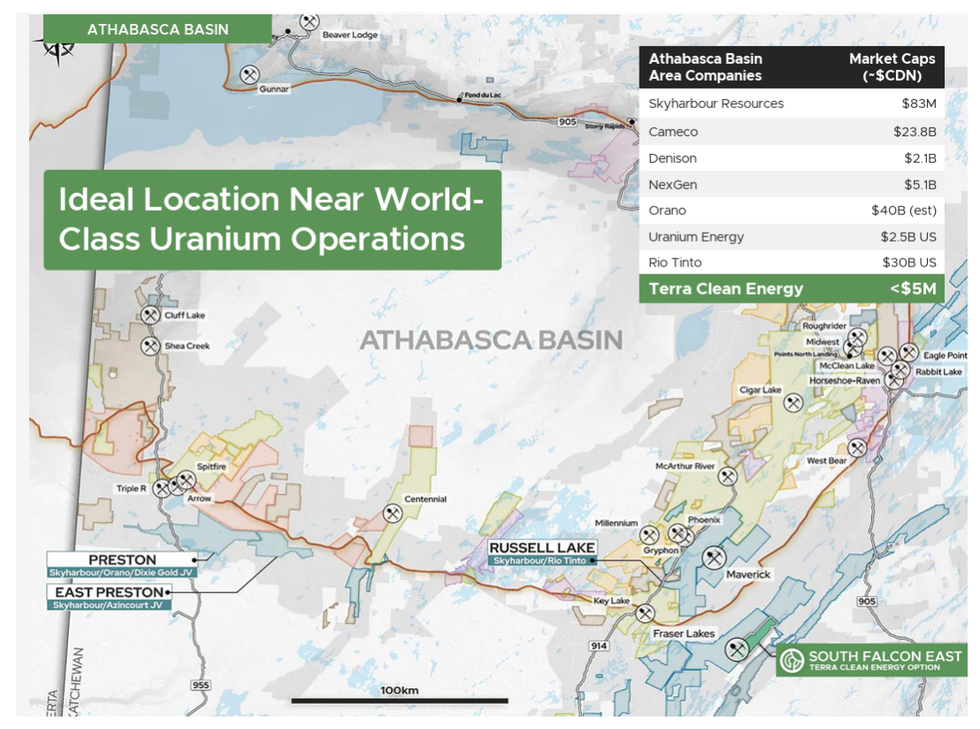
South Falcon East, Terra Clean Energy’s flagship project, spans 12,234 hectares on the southeastern margin of the Athabasca Basin, Saskatchewan, just 55 km east of the historic Key Lake uranium mill. The project hosts the Fraser Lakes Zone B deposit, with a historical inferred resource of 6.96 Mlbs U₃O₈ at 0.03% and 5.34 Mlbs ThO₂ at 0.023 percent, contained within 10.35 Mt using a 0.01 percent U₃O₈ cutoff. While not yet classified under NI 43-101, Terra considers the resource data reliable and a strong foundation for future exploration and growth.
Company Highlights
- Unique, Shallow Uranium System: Only micro-cap in the Athabasca Basin advancing a near-surface uranium deposit, with significantly reduced exploration and potential development costs.
- Pounds-in-the-ground Upside: Historical resource of 6.96 Mlbs U₃O₈ and 5.34 Mlbs ThO₂, with considerable expansion potential from historical and recent drilling.
- Prime Location: Situated 55 km east of the Key Lake Mill within the prolific Athabasca Basin – home to the world’s highest-grade uranium deposits.
- Strong Technical Leadership: Led by a team with extensive uranium exploration and capital markets experience, including veterans from Skyharbour Resources and Azincourt Energy.
- Resource Update Underway: 2024–25 infill and step-out drilling will support an NI 43-101 compliant mineral resource estimate, incorporating higher-grade intercepts from Terra’s 2024 campaign.
- Re-rating Potential: Market cap under $5 million despite having a historical uranium resource, confirmed mineralized zones, and near-term catalysts.
This Terra Clean Energy profile is part of a paid investor education campaign.*
Click here to connect with Terra Clean Energy (CSE:TCEC) to receive an Investor Presentation
Keep reading...Show less
30 June
Terra Clean Energy
Investor Insight
With a clear, discovery-focused strategy, Terra Clean Energy is advancing one of the most unique near-surface uranium opportunities in the Athabasca Basin, targeting rapid resource growth and re-rating potential through continuous exploration, aggressive drilling, and disciplined capital deployment.
Overview
Terra Clean Energy (CSE:TCEC,OTCQB:TCEFF,FSE:C9O0) is unlocking value from its wholly owned South Falcon East project, located in the southeastern Athabasca Basin in Saskatchewan, Canada. The project uniquely positions Terra among uranium juniors due to its shallow mineralization and proximity to world-class infrastructure.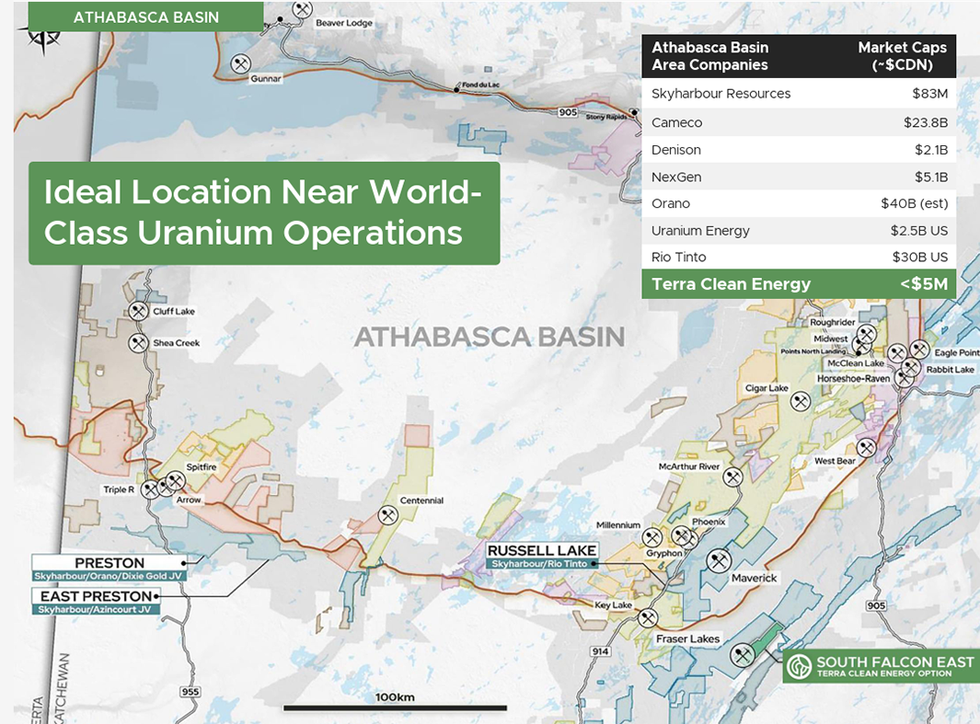
With a historical uranium resource of nearly 7 million lbs (Mlbs) U₃O₈ at Fraser Lakes Zone B, and multiple zones of confirmed mineralization and structural alteration, Terra is targeting an updated NI 43-101 resource in 2025, aiming to significantly grow its asset base. The project’s location along the Way Lake Conductor – a folded, fertile corridor – offers blue-sky potential for additional discoveries.
As global demand for uranium surges due to energy security concerns and the electrification boom (AI, EVs, nuclear baseload), Terra offers investors a rare combination of historical resource foundation, shallow mineralization, and transformational growth potential at a micro-cap valuation.
Company Highlights
- Unique, Shallow Uranium System: Only micro-cap in the Athabasca Basin advancing a near-surface uranium deposit, with significantly reduced exploration and potential development costs.
- Pounds-in-the-ground Upside: Historical resource of 6.96 Mlbs U₃O₈ and 5.34 Mlbs ThO₂, with considerable expansion potential from historical and recent drilling.
- Prime Location: Situated 55 km east of the Key Lake Mill within the prolific Athabasca Basin – home to the world’s highest-grade uranium deposits.
- Strong Technical Leadership: Led by a team with extensive uranium exploration and capital markets experience, including veterans from Skyharbour Resources and Azincourt Energy.
- Resource Update Underway: 2024–25 infill and step-out drilling will support an NI 43-101 compliant mineral resource estimate, incorporating higher-grade intercepts from Terra’s 2024 campaign.
- Re-rating Potential: Market cap under $5 million despite having a historical uranium resource, confirmed mineralized zones, and near-term catalysts.
Key Project
South Falcon East – Fraser Lakes B Deposit
Located in the southeastern margin of the Athabasca Basin, Saskatchewan, South Falcon East is Terra Clean Energy’s flagship project, covering approximately 12,234 hectares of prospective uranium ground. The property lies 55 km east of the historic Key Lake uranium mill and hosts the Fraser Lakes B deposit, which hosts an inferred historical resource of 6.96 Mlb U₃O₈ at 0.03 percent and 5.34 Mlb thorium dioxide (ThO₂) at 0.023 percent, within 10.35 Mt of material using a 0.01 percent U₃O₈ cutoff grade. While this resource is not currently classified under NI 43-101, Terra believes the data is reliable and serves as a robust foundation for continued exploration.
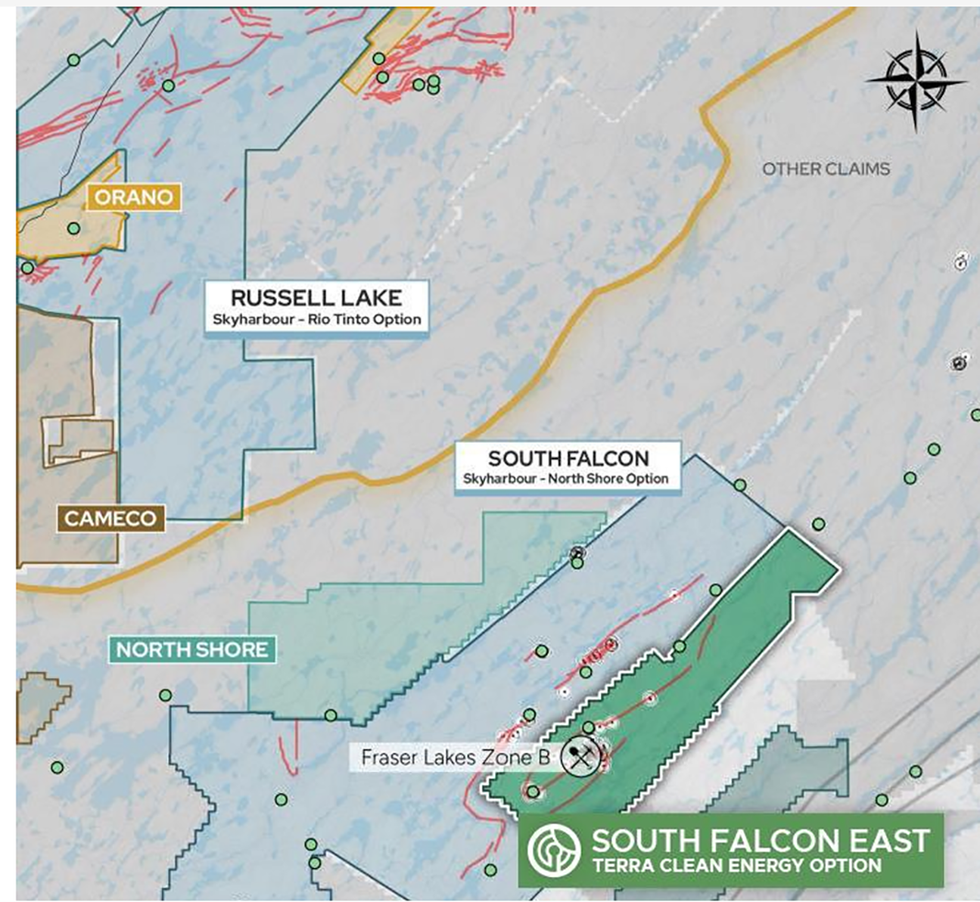
The mineralization is hosted in fractured and altered pegmatites and graphitic pelitic paragneiss, with the uranium accompanied by thorium and elevated concentrations of copper, nickel, vanadium, zinc, bismuth, molybdenum, lead and cobalt. Alteration assemblages include illite, dickite, kaolinite, chlorite, fluorite and hematite; these are classic markers of basement-hosted unconformity uranium systems. This setting, along with widespread clay alteration and structural disruption, mirrors some of the most prolific uranium systems in the basin, including Eagle Point, Millennium and Roughrider.
Fraser Lakes B sits on the central limb of the Way Lake Conductor, a folded EM corridor extending more than 25 km across the project area. This conductor hosts three major fold limbs (West, Central, and East), but only the central limb, where Fraser Lakes B is located, has been materially drilled. The deposit currently exhibits a strike length of approximately 1,400 meters, dipping northwest, and remains open in all directions. A north-northeast-trending fault, known as the T-Bone Lineament, intersects the deposit’s eastern margin, suggesting additional structural complexity and potential uranium conduits along strike.
Historic drilling from 2008 to 2015 by Skyharbour Resources and JNR Resources identified numerous mineralized intervals. Highlights include:
- 0.165 percent U₃O₈ over 2 m (within a broader 6 m grading 0.103 percent U₃O₈) in FP-15-05.
- 0.183 percent U₃O₈ over 1 m in WYL-50.
- 0.242 percent U₃O₈ over 0.5 m in WYL-61.
- 0.057 percent U₃O₈ over 5.5 m in the same hole.
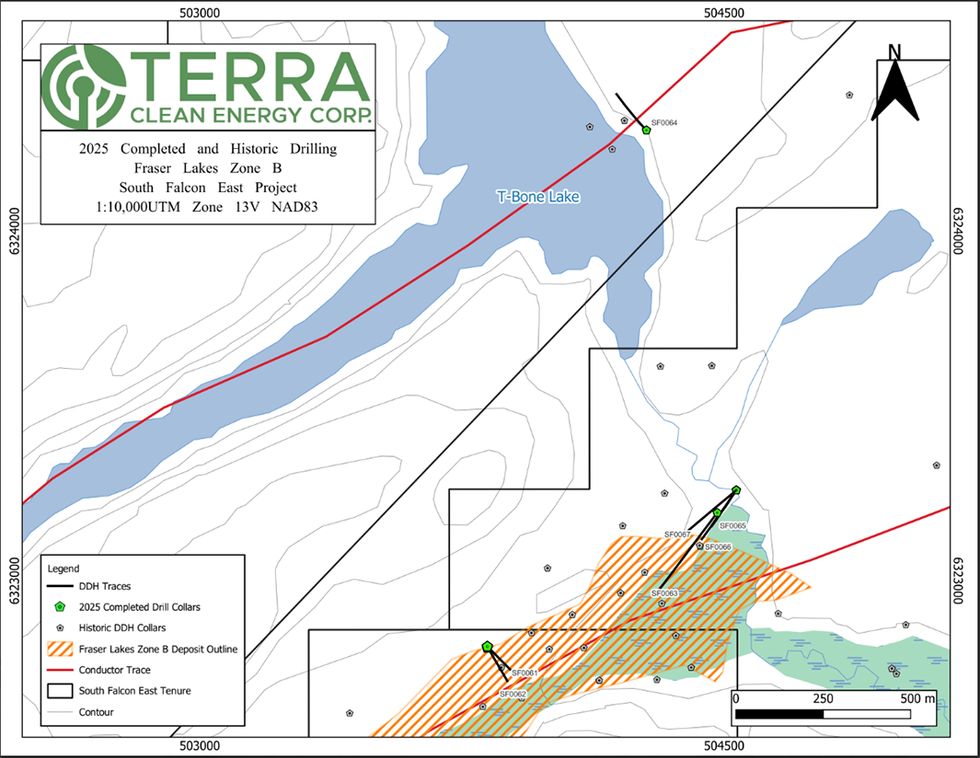
These results demonstrate multiple stacked mineralized horizons over widths up to 65 m, open to depth and laterally.
In early 2024, Terra’s Phase 1 drill program confirmed the presence of uranium-bearing pegmatites in close proximity to historical intercepts. Hole SF-0059 intersected 13.5 m of mineralization, including 0.07 percent eU₃O₈ over 1.1 m, while SF-0060 returned intervals such as 0.02 percent eU₃O₈ over 1.3 m at 142.15 m. These intercepts confirm the extension of mineralization along strike and at depth from FP-15-05 and support the hypothesis of lateral continuity and stacked mineralized bodies.
Planning for an extensive summer 2025 drill program is underway, which consists of approximately 2,500 meters. The program will test areas identified during the winter 2024 program, where it is interpreted that a north-northwest trending brittle structure, a north dipping structure with strong clay alteration, and mineralized pegmatites with hydrothermal hematite alteration hosted in graphitic pelitic gneiss all intersect.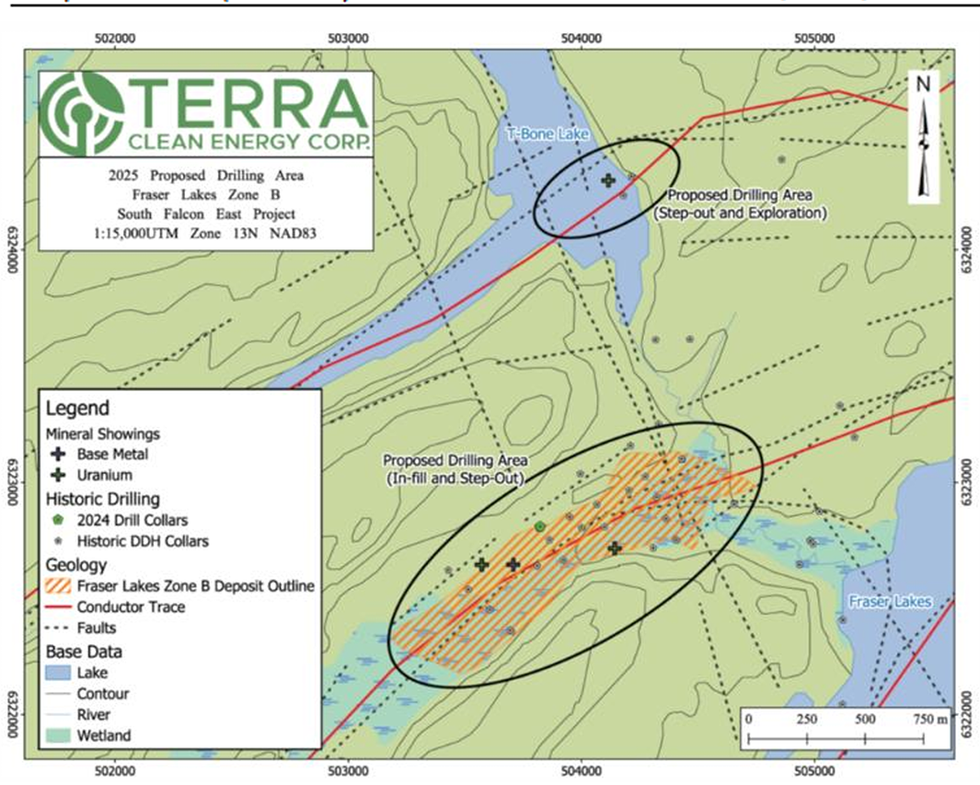
In addition to Fraser Lakes B, the company is evaluating regional targets such as T-Bone Lake, which has returned values up to 0.055 percent U₃O₈ over 0.9 m and features promising clay alteration and structural complexity similar to known high-grade deposits.
The overarching exploration thesis is that the Way Lake Conductor may host a clustered uranium system, with multiple deposits along its folded structure. Very little drilling has been conducted outside the current Fraser Lakes B footprint, giving Terra significant discovery potential across the entire 25 km strike length.
Management Team
Greg Cameron – President, CEO and Director
A seasoned capital markets professional, Greg Cameron has two decades of experience in business development, strategy and M&A. He is a former senior banker at Canaccord Genuity and Macquarie, and managing director at Colby Capital. He brings transactional and restructuring expertise critical to junior exploration growth.
C. Trevor Perkins – VP, Exploration
A professional geologist, C. Trevor Perkins has a track record in uranium exploration, including major results in the Athabasca Basin. He also serves as VP exploration for Azincourt Energy and has led exploration strategy and drill execution across multiple high-impact programs.
Alex Klenman – Director
Alex Klenman is a veteran junior mining executive with 30+ years’ experience, including uranium-specific roles. He is the CEO and director of Azincourt Energy, and has raised more than $18 million for Athabasca exploration. Klenman brings deep investor relations and financing expertise.
Tony Wonnacott – Director
Tony Wonnacott is a Toronto-based securities lawyer with more than 25 years of experience in capital markets. Instrumental in multiple successful listings and over $1 billion in financings and M&A transactions.
Brian Shin – CFO
Brian Shine is a chartered professional accountant with 15 years’ experience across roles in public companies. He specializes in reporting, risk management and corporate finance.
Jordan Trimble – Technical Advisor
Jordan Trimble is the CEO of Skyharbour Resources and a leading voice in the uranium investment community. He brings global capital markets insight and technical expertise, enhancing Terra’s industry reach and credibility.
Keep reading...Show less
29 June
A$4.5M Placement to Underpin Resource Growth Strategy
Latest News
Latest Press Releases
Related News
TOP STOCKS
American Battery4.030.24
Aion Therapeutic0.10-0.01
Cybin Corp2.140.00



